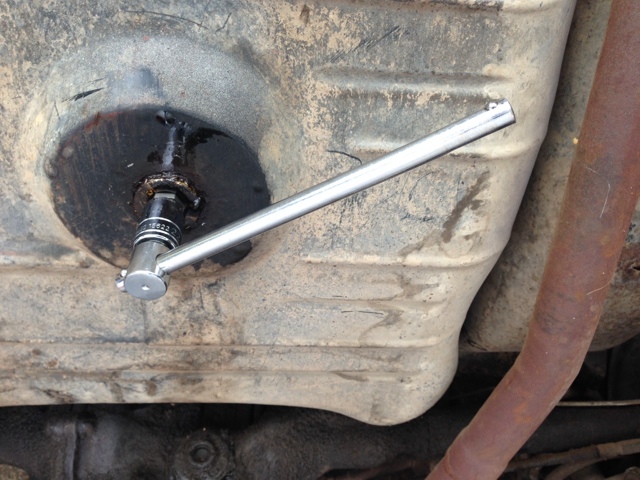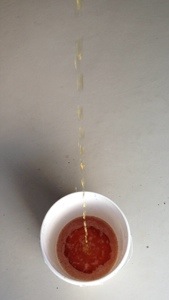 Unearthed from the fuel tank, this piece looks like it has been salvaged from the sea floor. It is (or was) the business end of the fuel sending unit. The metal rod, partially in view, is connected to a plastic float at the extreme end. This float will bob up or down and mechanically position the arm as the fuel level changes. That pivot point, behind the gruesome mess, is locked up solid. I will attempt to chip away the corrosion and free the shaft. Peering into the tank itself revealed no similar horrors. Plenty of debris and rust but no stalactites or stalagmites artefacts. It will need to be boiled out.
Unearthed from the fuel tank, this piece looks like it has been salvaged from the sea floor. It is (or was) the business end of the fuel sending unit. The metal rod, partially in view, is connected to a plastic float at the extreme end. This float will bob up or down and mechanically position the arm as the fuel level changes. That pivot point, behind the gruesome mess, is locked up solid. I will attempt to chip away the corrosion and free the shaft. Peering into the tank itself revealed no similar horrors. Plenty of debris and rust but no stalactites or stalagmites artefacts. It will need to be boiled out.
Tag Archives: Ponton
Value Added
 A professional restorer would be delighted to find these markings. Scribbled 50 years ago by a factory worker; they served as a production note during assembly. The markings have been accidentally preserved by a patina of dirt and petroleum grime. Best I can tell the red painted notation was applied when the tank was stockpiled as it displays upside down as installed. There are other remnant yellow dabs of paint here or there. A simple brush stroke that indicates that a fitting was checked for tightness or inspected in some way. These original markings will be lost when the tank is rejuvenated with a fresh black protective coat and that is one of the issues with restoration: originality is lost. It sounds anal, but a dedicated restorer would document these glyphics* and, following the refurbish , take steps to re-create them just as they were, thus preserving authenticity.
A professional restorer would be delighted to find these markings. Scribbled 50 years ago by a factory worker; they served as a production note during assembly. The markings have been accidentally preserved by a patina of dirt and petroleum grime. Best I can tell the red painted notation was applied when the tank was stockpiled as it displays upside down as installed. There are other remnant yellow dabs of paint here or there. A simple brush stroke that indicates that a fitting was checked for tightness or inspected in some way. These original markings will be lost when the tank is rejuvenated with a fresh black protective coat and that is one of the issues with restoration: originality is lost. It sounds anal, but a dedicated restorer would document these glyphics* and, following the refurbish , take steps to re-create them just as they were, thus preserving authenticity.
* guess translation is that ” 128 CA” meant that this fuel tank was intended for a particular application and is shorthand for W128 an internal factory designator for this production series. I can speculate that “CA” is short for Cabriolet.
Progress means stamped numbers and barcodes are applied which can be scanned and tracked like a parcel or airline luggage. Just as well — in case we can’t read his writing.
A Smoking Gun
 Tank Drain Plug: fuel screen clogged with varnish
Tank Drain Plug: fuel screen clogged with varnish
 Tank Drain Plug: fuel screen cleaned and restored
Tank Drain Plug: fuel screen cleaned and restored
This is a pre-filter. It is intended to protect the fuel pump and fuel lines from large debris — trash that might have fallen into the tank during refueling. There is a baffle in the lower part of the tank, a false floor, creating a collector. The plug has dual threads. The top set of threads seals against the bottom of the main container. Fuel enters the screen and exits an orifice (below the top set of threads) and into the collector area. Fuel is drawn from the collector by pump.
Ageing gasoline eventually blocked this screen effectively choking any and all fuel flow. And, this is the reason why the engine ceased running. Its discovery was an ah hah moment.
Long Term Effects
The contents were fresh 15 years ago and by today’s date, way past expiration. Old gas, while still flammable, will no longer combust reliably in an engine and will coat fuel systems with residue and varnish; in other words — gum up the works.

A 22mm Hex Key socket inserted bottom of tank to unscrew drain plug. It was a nice thought that the engineers included one. Bean counters found out and you never see this feature anymore as you can imagine it is one that is seldom called for. I was concerned I would not be able to loosen it as threaded fittings have a tendency to seize. If the original was over torqued or there is rust corrosion then it might be impossible to remove. Steel tank but the plug is brass with an aluminum washer so no rust but dissimilar metals can still create problems. An extension arm (cheater bar) on this tool provided sufficient leverage to break it loose.
The discolored, stale, stinky gas and can be properly disposed of…

New Bling
The Parts Advisor at the Classic Center informs by email that the desired replacement Trunk Emblem estimate is $$$ (wow) and confides that upon clicking — send that he “turned to his co-worker and quipped; we’ll never hear from THAT guy again…”
I can confirm that automobile restoration is a rich man’s hobby, but this old car is incomplete without this star piece (eclipsed only by the hood ornament).
Not convinced that my queried trim item is NOS or a reproduction. Short of melting metal and casting myself, the alternative would be to locate a donor car in a salvage yard that has not already given up its shiny bits. Not likely as 20 – 30 years will have elapsed.
When they FedEx, I trust that they will insure with care.
Getting Fuel
Lurking beneath the trunk floor mat is the wiring for the fuel sending unit. One wire to the fuel quantity gauge and one for the low fuel warning light. A 3rd wire, upper right, is for grounding. The 5 securing nuts with washers removed without grief as there was no corrosion on the threads but the unit itself will not separate from the fuel tank. Its cork gasket has bonded itself to the tank top.
Disconnecting these wires is only one step in the fuel tank removal. The fuel filler neck hose coupling, expansion line, fuel feed and fuel return lines all have to be detached. Finally there are 3 mounting bolts securing the tank to the chassis frame to be loosened.
The objective is to drain the stale gasoline that has deteriorated during long term storage. Residual varnish and gum must be flushed before fresh gas can be added, necessitating its removal. And, after the tank has been dropped down I can better access that “glued on” sending unit and restore a fresh gasket.
Chrome Top Tip
Little chrome is to be found on newer cars. Porsche started a sporting trend a number of years ago with blacked out chrome trim. Other manufacturers, such as tuner AMG, adopted the theme as a cool new look which style led to: monochrome. It helped that the abandonment of chromium saved money in the process. Eventually body trim, cladding, bumper covers and exterior pieces became plasticized and the chrome bits were totally disused. As you may recall, the flamboyant use of chrome popularly peaked in the 1950’s. Even interiors and instrument panels enjoyed liberal usage. A topical issue was the glare and distraction when the sun angled just so. Acres of chrome require maintenance upkeep. This polishing technique may be of little value unless you are resurrecting an older car but is interesting even if you’re not because — who knew?
A number of youtube and forum tipsters advocate using Coca-Cola in lieu of water as an effective agent. Evidently the beverage contains phosphoric acid which aids in rust removal. Considering a messy clean up I went with plain water and a moderate amount of elbow grease.


